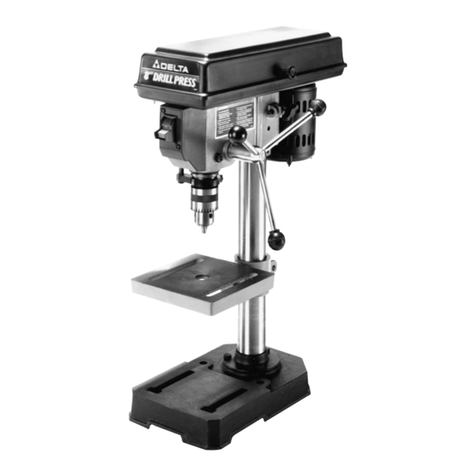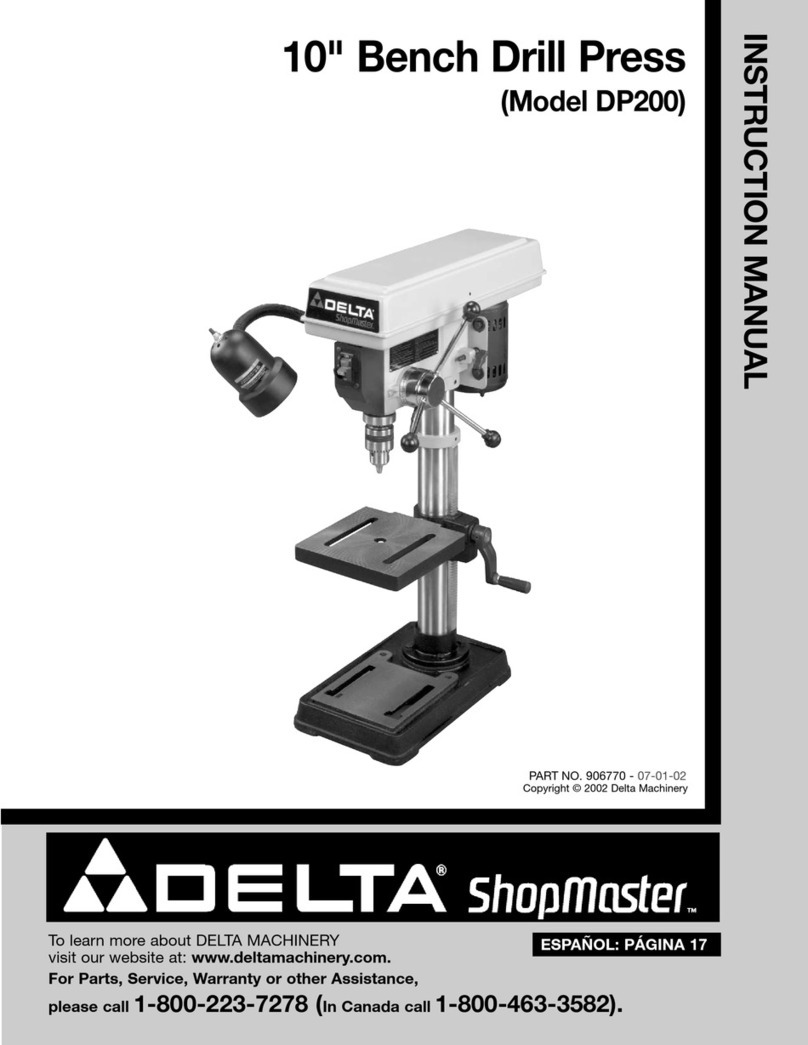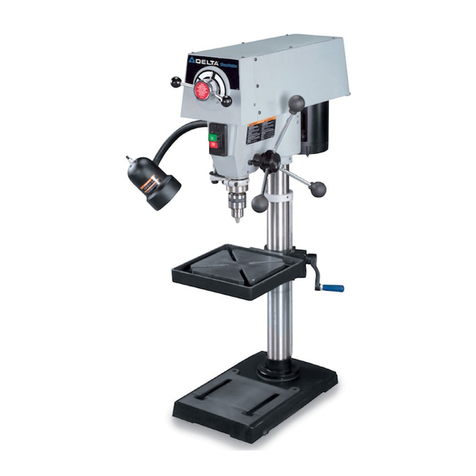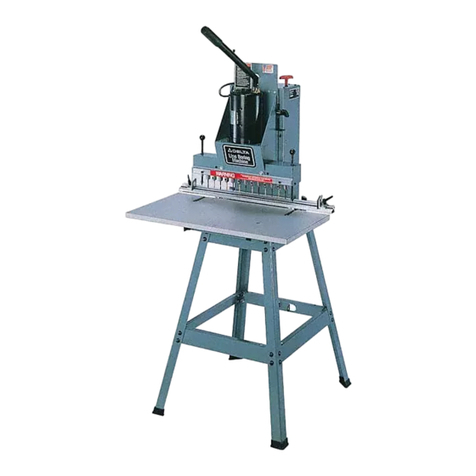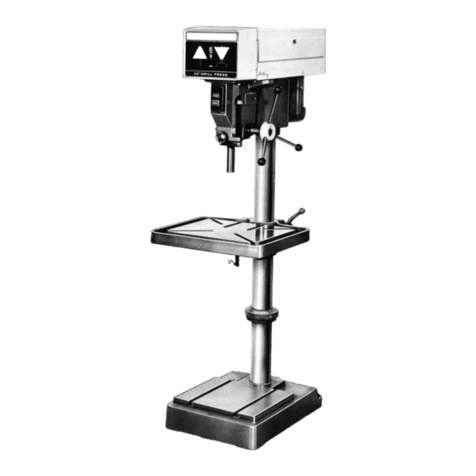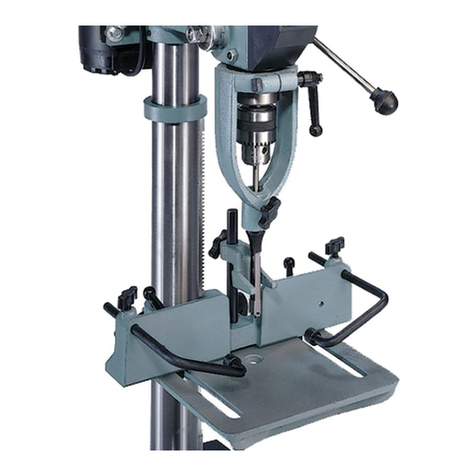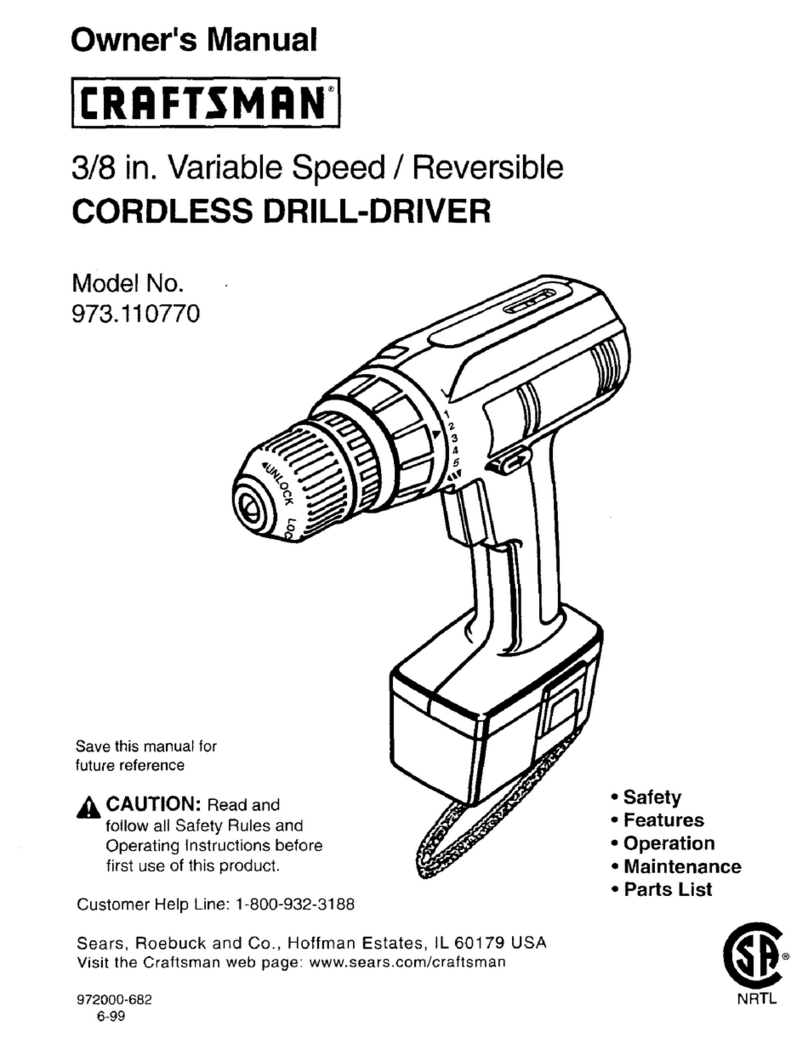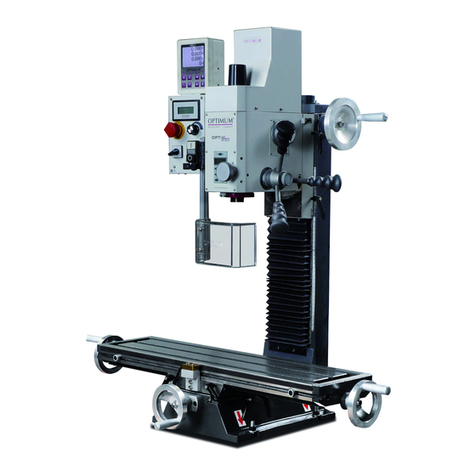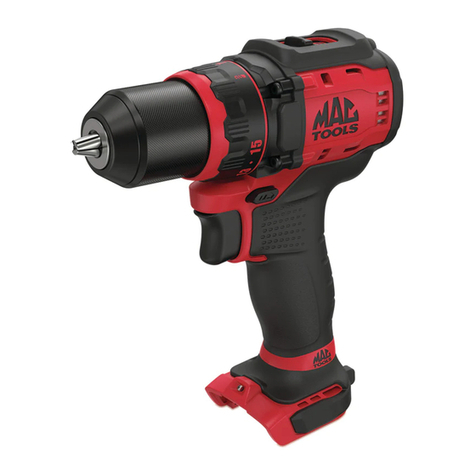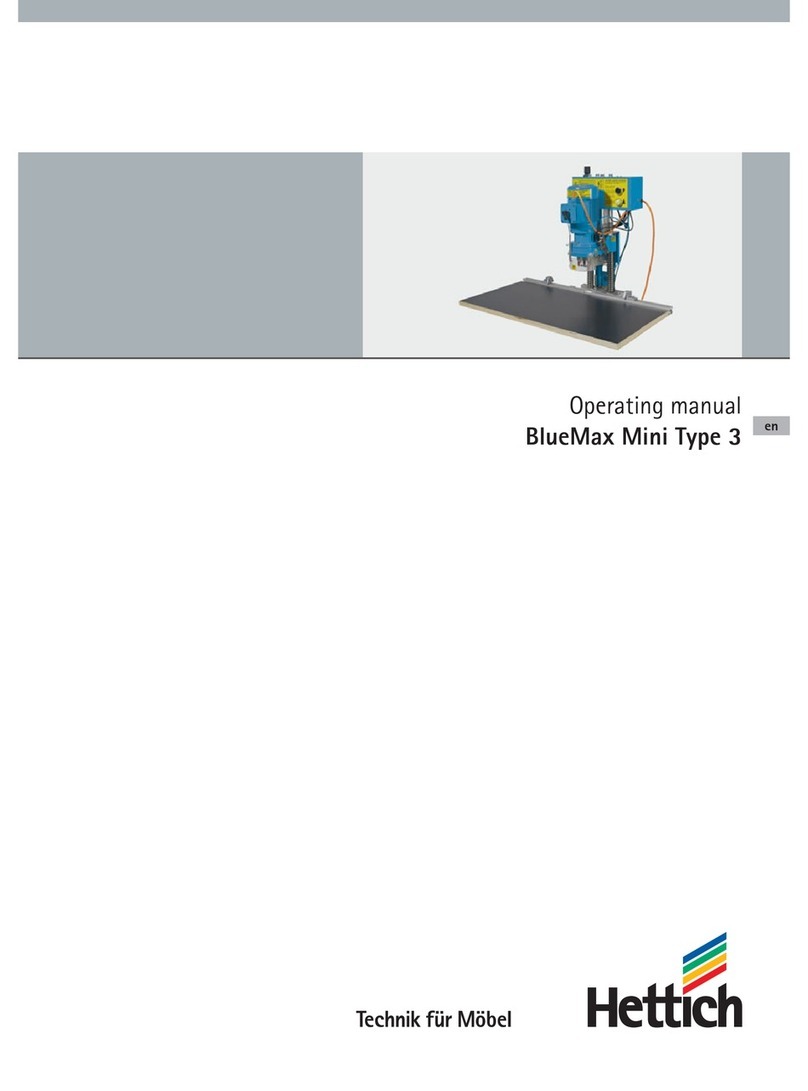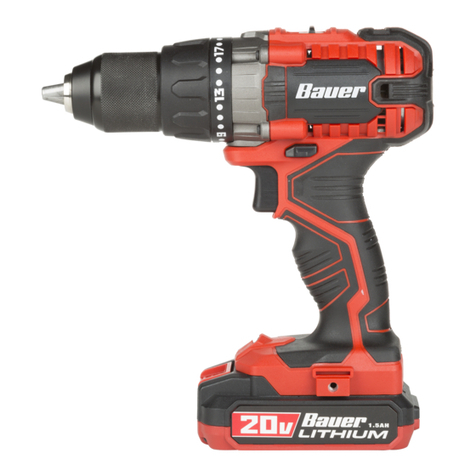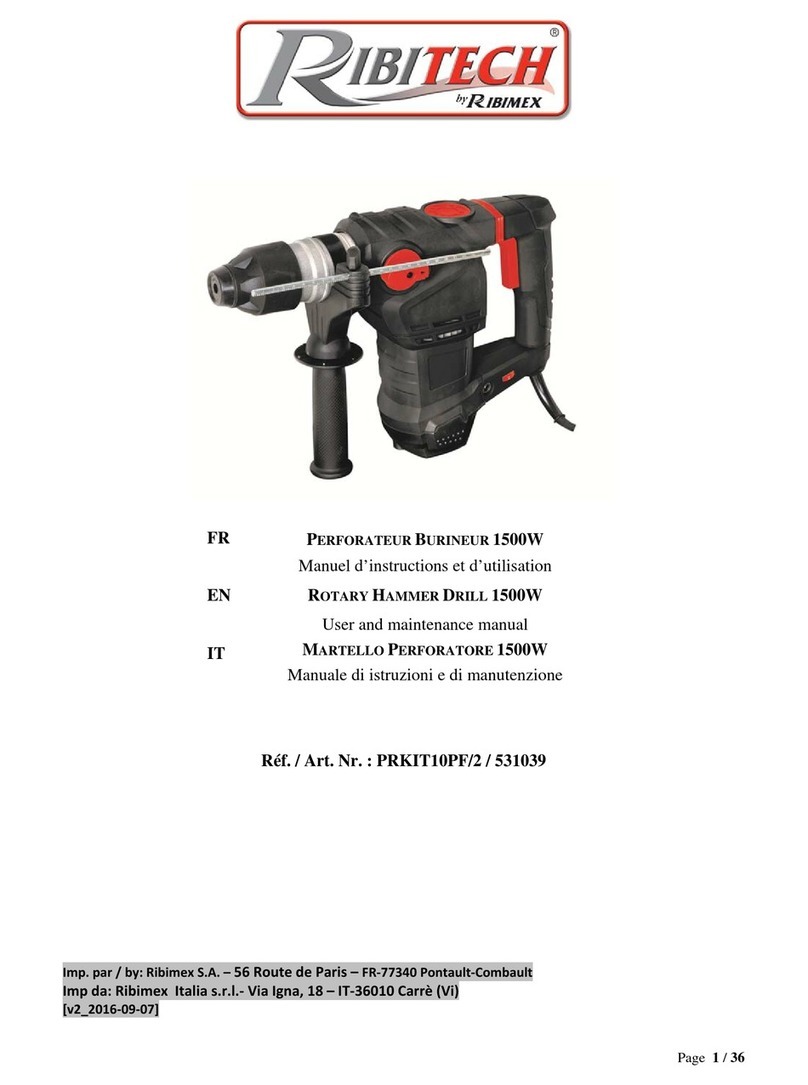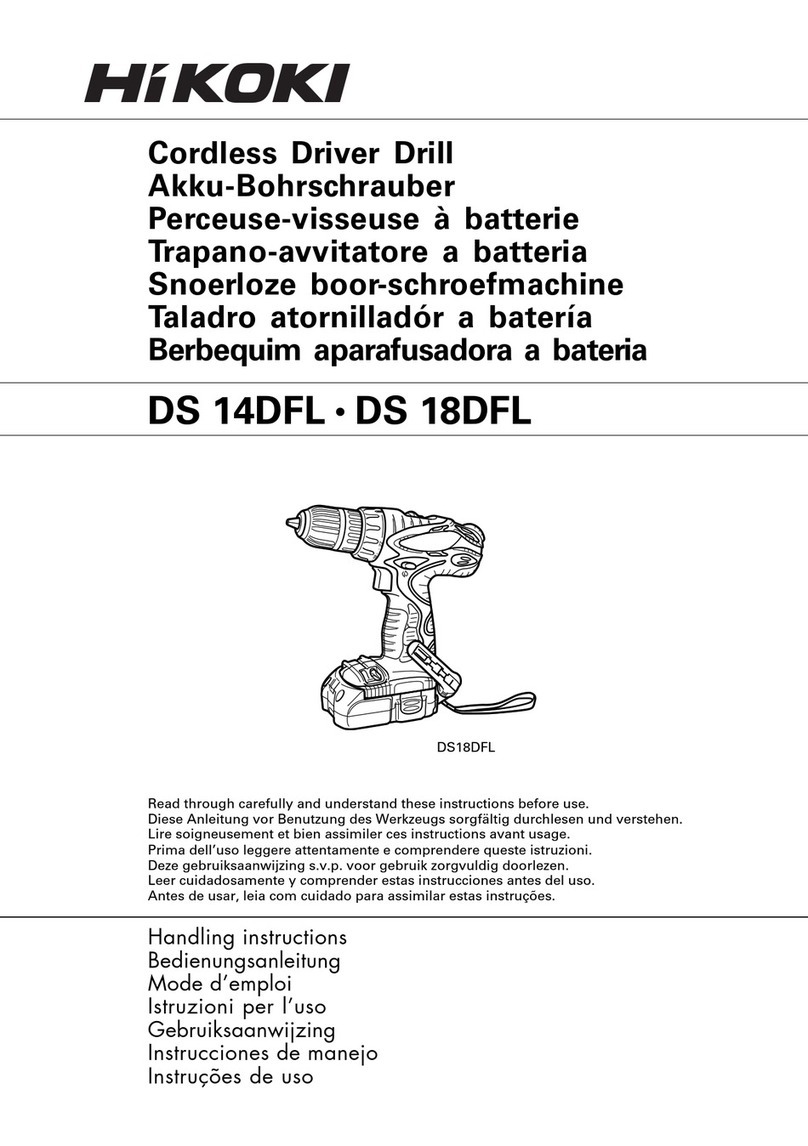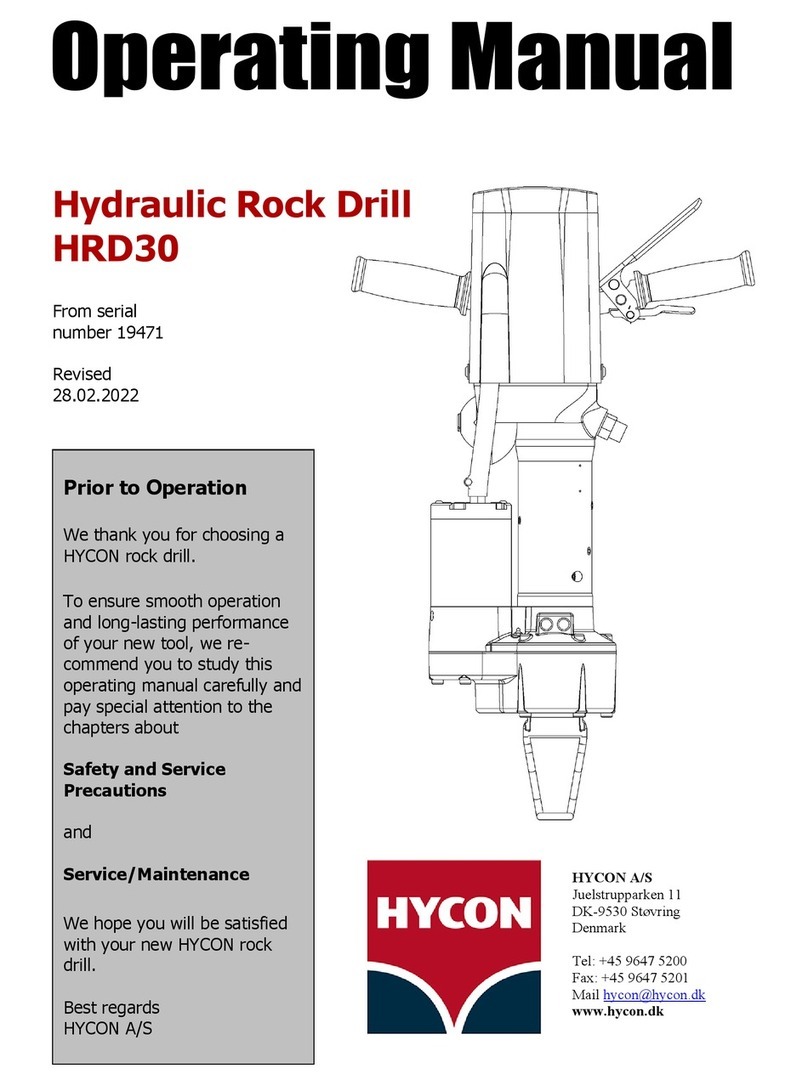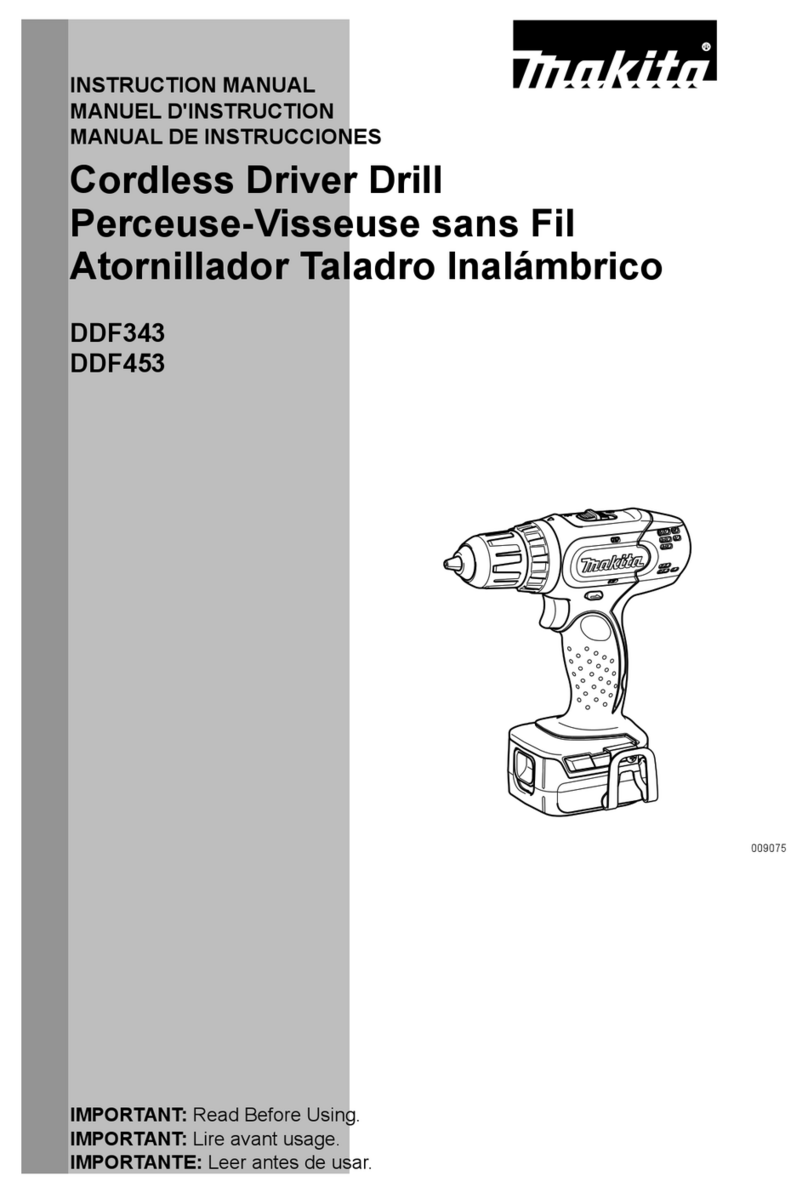Delta 14-65l User manual

www.deltamachinery.com
(800) 223-7278 - US
(800) 463-3582 - CANADA
Hollow Chisel
Mortiser
Instruction Manual
Manuel d’utilisation
Manual de instrucciones
14-651
FRANÇAIS (15) ESPAÑOL (27)
A19592 - 09-15-06
Copyright © 2006 Delta Machinery
Mortaiseuse
à bédane creux
Mortajadora de
cincel hueco

2 - English
TABLE OF CONTENTS
IMPORTANT SAFETY INSTRUCTIONS
Read and understand all warnings and operating instructions before using any tool
or equipment. When using tools or equipment, basic safety precautions should always be followed
to reduce the risk of personal injury. Improper operation, maintenance or modification of tools or
equipment could result in serious injury and property damage. There are certain applications for which
tools and equipment are designed. Delta Machinery strongly recommends that this product NOT be modified and/or
used for any application other than for which it was designed.
SAFETY GUIDELINES - DEFINITIONS
CALIFORNIA PROPOSITION 65
Some dust created by power sanding, sawing, grinding, drilling, and other construction activities
contains chemicals known to cause cancer, birth defects or other reproductive harm. Some
examples of these chemicals are:
• lead from lead-based paints,
• crystalline silica from bricks and cement and other masonry products, and
• arsenic and chromium from chemically-treated lumber.
Your risk from these exposures varies, depending on how often you do this type of work. To reduce your
exposure to these chemicals: work in a well ventilated area, and work with approved safety equipment, always
wear NIOSH/OSHA approved, properly fitting face mask or respirator when using such tools.
IMPORTANT SAFETY INSTRUCTIONS ....................2
SAFETY GUIDELINES - DEFINITIONS .....................3
GENERAL SAFETY RULES .......................................3
ADDITIONAL SPECOFOC SAFETY RULES .............4
FUNCTIONAL DESCRIPTION ...................................6
CARTON CONTENTS ...............................................6
ASSEMBLY .................................................................7
OPERATION ...............................................................10
If you have any questions relative to its application DO NOT use the product until you have written Delta Machinery and
we have advised you. Contact us online at www.deltamachinery.com or by mail at Technical Service Manager, Delta
Machinery, 4825 Highway 45 North, Jackson, TN 38305. In Canada,125 Mural St. Suite 300, Richmond Hill, ON, L4B 1M4)
Information regarding the safe and proper operation of this tool is available from the following sources:
• Power Tool Institute, 1300 Sumner Avenue, Cleveland, OH 44115-2851or online at www.powertoolinstitute.org
• National Safety Council, 1121 Spring Lake Drive, Itasca, IL 60143-3201
• American National Standards Institute, 25 West 43rd Street, 4 floor, New York, NY 10036 www.ansi.org - ANSI 01.1
Safety Requirements for Woodworking Machines
• U.S. Department of Labor regulations www.osha.gov
SAVE THESE INSTRUCTIONS!
TROUBLESHOOTING................................................12
MAINTENANCE..........................................................12
SERVICE.....................................................................13
ACCESSORIES...........................................................13
WARRANTY................................................................14
FRANÇAIS ..................................................................15
ESPAÑOL....................................................................27
It is important for you to read and understand this manual. The information it contains relates to protecting YOUR SAFETY
and PREVENTING PROBLEMS. The symbols below are used to help you recognize this information.
Indicates an imminently hazardous situation which, if not avoided, will result in death or serious
injury.
Indicates a potentially hazardous situation which, if not avoided, could result in death or serious
injury.
Indicates a potentially hazardous situation which, if not avoided, may result in minor or moderate
injury.
Used without the safety alert symbol indicates a potentially hazardous situation which, if not avoided,
may result in property damage.

3 - English
1. FOR YOUR OWN SAFETY, READ THE INSTRUCTION
MANUAL BEFORE OPERATING THE MACHINE. Learning
the machine’s application, limitations, and specific hazards
will greatly minimize the possibility of accidents and injury.
2. WEAR EYE AND HEARING PROTECTION. ALWAYS
USE SAFETY GLASSES. Everyday eyeglasses are NOT
safety glasses. USE CERTIFIED SAFETY EQUIPMENT.
Eye protection equipment should comply with ANSI Z87.1
standards. Hearing equipment should comply with ANSI
S3.19 standards.
3. WEAR PROPER APPAREL. Do not wear loose clothing,
gloves, neckties, rings, bracelets, or other jewelry which may
get caught in moving parts. Nonslip protective footwear is
recommended. Wear protective hair covering to contain long
hair.
4. DO NOT USE THE MACHINE IN A DANGEROUS
ENVIRONMENT. The use of power tools in damp or wet
locations or in rain can cause shock or electrocution. Keep
your work area well-lit to prevent tripping or placing arms,
hands, and fingers in danger.
5. MAINTAIN ALL TOOLS AND MACHINES IN PEAK
CONDITION. Keep tools sharp and clean for best and safest
performance. Follow instructions for lubricating and changing
accessories. Poorly maintained tools and machines can further
damage the tool or machine and/or cause injury.
6. CHECK FOR DAMAGED PARTS. Before using the machine,
check for any damaged parts. Check for alignment of moving
parts, binding of moving parts, breakage of parts, and any
other conditions that may affect its operation. A guard or any
other part that is damaged should be properly repaired or
replaced with Delta or factory authorized replacement
parts. Damaged parts can cause further damage to the
machine and/or injury.
7. KEEP THE WORK AREA CLEAN. Cluttered areas and benches
invite accidents.
8. KEEP CHILDREN AND VISITORS AWAY. Your shop is a
potentially dangerous environment. Children and visitors can be
injured.
9. REDUCE THE RISK OF UNINTENTIONAL STARTING. Make
sure that the switch is in the “OFF” position before plugging
in the power cord. In the event of a power failure, move the
switch to the “OFF” position. An accidental start-up can cause
injury. Do not touch the plug’s metal prongs when unplugging
or plugging in the cord.
10. USE THE GUARDS. Check to see that all guards are in place,
secured, and working correctly to prevent injury.
11. REMOVE ADJUSTING KEYS AND WRENCHES BEFORE
STARTING THE MACHINE. Tools, scrap pieces, and other
debris can be thrown at high speed, causing injury.
12. USE THE RIGHT MACHINE. Don’t force a machine or an
attachment to do a job for which it was not designed. Damage
to the machine and/or injury may result.
13. USE RECOMMENDED ACCESSORIES. The use of
accessories and attachments not recommended by Delta
may cause damage to the machine or injury to the user.
14. USE THE PROPER EXTENSION CORD. Make sure your
extension cord is in good condition. When using an extension
cord, be sure to use one heavy enough to carry the current
your product will draw. An undersized cord will cause a drop
in line voltage, resulting in loss of power and overheating. See
the Extension Cord Chart for the correct size depending on
the cord length and nameplate ampere rating. If in doubt, use
the next heavier gauge. The smaller the gauge number, the
heavier the cord.
15. SECURE THE WORKPIECE. Use clamps or a vise to hold the
workpiece when practical. Loss of control of a workpiece can
cause injury.
16. FEED THE WORKPIECE AGAINST THE DIRECTION OF
THE ROTATION OF THE BLADE, CUTTER, OR ABRASIVE
SURFACE. Feeding it from the other direction will cause the
workpiece to be thrown out at high speed.
17. DON’T FORCE THE WORKPIECE ON THE MACHINE.
Damage to the machine and/or injury may result.
18. DON’T OVERREACH. Loss of balance can make you fall into
a working machine, causing injury.
19. NEVER STAND ON THE MACHINE. Injury could occur if the tool
tips, or if you accidentally contact the cutting tool.
20. NEVER LEAVE THE MACHINE RUNNING UNATTENDED.
TURN THE POWER OFF. Don’t leave the machine until it comes
to a complete stop. A child or visitor could be injured.
21. TURN THE MACHINE “OFF”, AND DISCONNECT THE
MACHINE FROM THE POWER SOURCE before installing or
removing accessories, changing cutters, adjusting or changing
set-ups. When making repairs, be sure to lock the start switch
in the “OFF” position. An accidental start-up can cause injury.
22. MAKE YOUR WORKSHOP CHILDPROOF WITH
PADLOCKS, MASTER SWITCHES, OR BY REMOVING
STARTER KEYS. The accidental start-up of a machine by a
child or visitor could cause injury.
23. STAY ALERT, WATCH WHAT YOU ARE DOING, AND USE
COMMON SENSE. DO NOT USE THE MACHINE WHEN
YOU ARE TIRED OR UNDER THE INFLUENCE OF DRUGS,
ALCOHOL, OR MEDICATION. A moment of inattention while
operating power tools may result in injury.
USE OF THIS TOOL CAN GENERATE
AND DISBURSE DUST OR OTHER AIRBORNE
PARTICLES, INCLUDING WOOD DUST, CRYSTALLINE
SILICA DUST AND ASBESTOS DUST. Direct particles away
from face and body. Always operate tool in well ventilated
area and provide for proper dust removal. Use dust collection
system wherever possible. Exposure to the dust may cause
serious and permanent respiratory or other injury, including
silicosis (a serious lung disease), cancer, and death. Avoid
breathing the dust, and avoid prolonged contact with dust.
Allowing dust to get into your mouth or eyes, or lay on your
skin may promote absorption of harmful material. Always use
properly fitting NIOSH/OSHA approved respiratory protection
appropriate for the dust exposure, and wash exposed areas
with soap and water.
GENERAL SAFETY RULES
Failure to follow these rules may result in serious personal injury.
24.
SAVE THESE INSTRUCTIONS.
Refer to them often and use them to instruct others.

4 - English
1. DO NOT OPERATE THIS MACHINE until it is completely
assembled and installed according to the instructions. A
machine incorrectly assembled can cause serious injury.
2. OBTAIN ADVICE from your supervisor, instructor, or
another qualified person if you are not thoroughly
familiar with the operation of this machine. Knowledge
is safety.
3. FOLLOW ALL WIRING CODES and recommended electrical
connections to prevent shock or electrocution.
4. SECURE THE MACHINE TO A SUPPORTING SURFACE.
Vibration can cause the machine to slide, walk, or tip over.
5. NEVER START THE MACHINE BEFORE CLEARING
THE TABLE OF ALL OBJECTS (tools, scrap pieces,
etc.). Debris can be thrown at high speed.
6. NEVER START THE MACHINE with the drill bit or
cutting tool against the workpiece. Loss of control of the
workpiece can cause serious injury.
7. PROPERLY LOCK THE DRILL BIT OR CUTTING TOOL IN
THE UNIT before operating this machine.
8. ADJUST the depth stop to avoid drilling into the table.
9. DO NOT attempt to mortise material that does not have
a flat surface, unless a suitable support is used.
10. USE ONLY DRILL BITS, CUTTING TOOLS, OR OTHER
ACCESSORIES with shank size recommended in your
instruction manual. The wrong size accessory can cause
damage to the machine and/or serious injury.
11. USE ONLY DRILL BITS OR CUTTING TOOLS that are
not damaged. Damaged items can cause malfunctions
that lead to injuries.
12. USE RECOMMENDED SPEEDS for all operations. Other
speeds may cause the machine to malfunction causing
damage to the machine and/or serious injury.
13. AVOID AWKWARD OPERATIONS AND HAND
POSITIONS. A sudden slip could cause a hand to move
into the bit.
14. KEEP ARMS, HANDS, AND FINGERS away from the
bit. Serious injury to the hand can occur.
15. ALWAYS position the holddown directly over the
workpiece to prevent the workpiece from lifting during
operation. Loss of control of the workpiece can cause
serious injury.
16. TURN THE MACHINE “OFF” AND WAIT FOR THE DRILL
BIT, CUTTING TOOL, OR SANDING DRUM TO STOP
TURNING prior to cleaning the work area, removing
debris, removing or securing work-piece, or changing
the angle of the table. A moving drill bit or cutting tool
can cause serious injury.
17. PROPERLY SUPPORT LONG OR WIDE work-pieces.
Loss of control of the workpiece can cause severe
injury.
18. NEVER PERFORM LAYOUT, ASSEMBLY OR SET-UP
WORK on the table/work area when the machine is
running. Serious injury can result.
19. TURN THE MACHINE “OFF”, disconnect the machine
from the power source, and clean the table/work area
before leaving the machine. LOCK THE SWITCH IN
THE “OFF” POSITION to prevent unauthorized use.
Someone else might accidentally start the machine and
cause serious injury to themselves.
20. ADDITIONAL INFORMATION regarding the safe
and proper operation of power tools (i.e. a safety
video) is available from the Power Tool Institute, 1300
Sumner Avenue, Cleveland, OH 44115-2851 (www.
powertoolinstitute.com). Information is also available
from the National Safety Council, 1121 Spring Lake
Drive, Itasca, IL 60143-3201. Please refer to the
American National Standards Institute ANSI 01.1 Safety
Requirements for Woodworking Machines and the U.S.
Department of Labor OSHA 1910.213 Regulations.
Failure to follow these rules may result in serious personal injury.
ADDITIONAL SPECIFIC SAFETY RULES
SAVE THESE INSTRUCTIONS.
Refer to them often and use them to instruct others.
POWER CONNECTIONS
A separate electrical circuit should be used for your machines. This circuit should not be less than #12 wire and should
be protected with a 20 Amp time lag fuse. If an extension cord is used, use only 3-wire extension cords which have
3-prong grounding type plugs and matching receptacle which will accept the machine’s plug. Before connecting the
machine to the power line, make sure the switch (s) is in the “OFF” position and be sure that the electric current is of
the same characteristics as indicated on the machine. All line connections should make good contact. Running on low
voltage will damage the machine.
Do not expose the machine to rain or operate the machine in damp locations.
MOTOR SPECIFICATIONS
Your machine is wired for 120 Volt, 60 HZ alternating current. Before connecting the machine to the power source, make
sure the switch is in the “OFF” position.
GROUNDING INSTRUCTIONS
This machine must be grounded while in use to protect the operator from electric shock.

5 - English
Fig. A
GROUNDED OUTLET BOX
CURRENT
CARRYING
PRONGS
GROUNDING BLADE
IS LONGEST OF THE 3 BLADES
GROUNDED OUTLET BOX
GROUNDING MEANS
ADAPTER
1. All grounded, cord-connected machines:
In the event of a malfunction or breakdown, grounding provides a path of least resistance for electric current to reduce
the risk of electric shock. This machine is equipped with an electric cord having an equipment-grounding conductor and
a grounding plug. The plug must be plugged into a matching outlet that is properly installed and grounded in accordance
with all local codes and ordinances.
Do not modify the plug provided - if it will not fit the outlet, have the proper outlet installed by a qualified electrician.
Improper connection of the equipment-grounding conductor can result in risk of electric shock.The conductor with
insulation having an outer surface that is green with or without yellow stripes is the equipment-grounding conductor. If
repair or replacement of the electric cord or plug is necessary, do not connect the equipment-grounding conductor to a live
terminal.
Check with a qualified electrician or service personnel if the grounding instructions are not completely understood, or if in
doubt as to whether the machine is properly grounded.
Use only 3-wire extension cords that have 3-prong grounding type plugs and matching 3-conductor receptacles that
accept the machine’s plug, as shown in Fig. A.
Repair or replace damaged or worn cord immediately.
2. Grounded, cord-connected machines intended for use on a supply circuit having a nominal rating less than 150 volts:
If the machine is intended for use on a circuit that has an outlet that looks like the one illustrated in Fig. A, the machine
will have a grounding plug that looks like the plug illustrated in Fig. A. A temporary adapter, which looks like the adapter
illustrated in Fig. B, may be used to connect this plug to a matching 2-conductor receptacle as shown in Fig. B if a
properly grounded outlet is not available. The temporary adapter should be used only until a properly grounded outlet can
be installed by a qualified electrician. The green-colored rigid ear, lug, and the like, extending from the adapter must be
connected to a permanent ground such as a properly grounded outlet box. Whenever the adapter is used, it must be held
in place with a metal screw.
NOTE: In Canada, the use of a temporary adapter is not permitted by the Canadian Electric Code.
In all cases, make certain that the receptacle in question is properly grounded. If you are not sure, have a
qualified electrician check the receptacle.
EXTENSION CORDS
Use proper extension cords. Make sure
your extension cord is in good condition and is a 3-wire
extension cord which has a 3-prong grounding type
plug and matching receptacle which will accept the
machine’s plug. When using an extension cord, be sure
to use one heavy enough to carry the current of the
machine. An undersized cord will cause a drop in line
voltage, resulting in loss of power and overheating. Fig.
D-1 shows the correct gauge to use depending on the
cord length. If in doubt, use the next heavier gauge. The
smaller the gauge number, the heavier the cord.
Fig. D-1
MINIMUM GAUGE EXTENSION CORD
RECOMMENDED SIZES FOR USE WITH STATIONARY ELECTRIC MACHINES
Ampere
Rating Volts
Total
Length of
Cord in
Feet Gauge of Extension
Cord
0-6 120
up to
25 18 AWG
0-6 120 25-50 16 AWG
0-6 120 50-100 16 AWG
0-6 120 100-150 14 AWG
6-10 120
up to
25 18 AWG
6-10 120 25-50 16 AWG
6-10 120 50-100 14 AWG
6-10 120 100-150 12 AWG
10-12 120
up to
25 16 AWG
10-12 120 25-50 16 AWG
10-12 120 50-100 14 AWG
10-12 120 100-150 12 AWG
12-16 120
up to
25 14 AWG
12-16 120 25-50 12 AWG
12-16 120 GREATER THAN 50 FEET NOT RECOMMENDED
Fig. B
Fig. A

6 - English
FOREWORD
FUNCTIONAL DESCRIPTION
NOTICE: The photo on the manual cover illustrates the current production model. All other illustrations contained in the
manual are representative only and may not depict the actual labeling or accessories included. These are intended to
illustrate technique only.
CARTON CONTENTS
The Delta Model 14-651 is easier to operate than a conventional drill press equipped with a mortising attachment. The
model 14-651 is made of cast-iron and steel for rigidity and stability, and comes with a standard 3-jaw type chuck for
positive gripping of mortising bits.
1
10. M6 x 1 x 25mm Pan Head Screws (2) (for attaching tool and
chisel holder)
11. Spring
12. Bushing (for use with extra long chisels)
13. M6 Lockwashers (2) (for assembling tool and chisel
holder)
14. 1/2" Mortising Chisel and Bit
15. 3/8" Mortising Chisel and Bit
16. 5/16" Mortising Chisel and Bit
17. 1/4" Mortising Chisel and Bit
1. Mortiser
2. Tool and Chisel Holder
3. Chuck Key / Wrench
4. Column Extension
5. Hydraulic Cylinder
6. Handle
7. Extended hold-down rod (use with column extension)
8. Special Screw (for raising and lowering handle)
9. M8 x 1.25 x 80mm Head Screw (4) (for attaching column
extension to base)
2
3
4
56
8
7
9
10
11
12
13
14
15
16
17

7 - English
ATTACHING THE TOOL AND CHISEL HOLDER
1. Attach the tool and chisel holder (A) Fig. 5 to the back of the column, using the two M6x1x25mm screws (B) and
M6 lockwashers.
2. Fig. 6 illustrates the stored chuck key/wrench (C), bushing (F) for use with extra long chisels, and chisels and bits (E).
RAISING AND LOWERING THE HANDLE
1. Attach the hub of the handle assembly (A) Fig. 1 to the end of the pinion shaft (B). Fasten the handle to the pinion
shaft using the special screw (C) and spring (D).
2. Raise the mortising machine head (E) Fig. 2 to the "up" position by turning the handle (A) clockwise.
NOTE: The handle (A) is spring-loaded. Reposition it by pulling it out and moving it on pinion shaft (B).
ATTACHING THE HYDRAULIC CYLINDER
Place the head (A) Fig. 3 in the “up” position. Attach the hydraulic cylinder (B) to the two fittings, one located on the
back of the head (C) Fig. 3, and the other on the column (D) Fig. 4. Push each end of the hydraulic cylinder on its fitting
to secure the cylinder.
Fig. 1 Fig. 2
B
E
B
A
Fig. 3 Fig. 4
C
A
B
D
B
A
B
B
A
F
CE
Fig. 5 Fig. 6
ASSEMBLY
For your own safety, do not connect the machine to the power source until the machine is
completely assembled and you read and understand the entire instruction manual.
A
D
C
ASSEMBLY TOOLS REQUIRED
ASSEMBLY TIME ESTIMATE
Assembly for this machine takes less than 30 minutes.
Chuck Key/Wrench (Supplied)

8 - English
If the machine has any tendency to tip over, slide,
or walk on the supporting surface, you must secure
the base of the machine to a supporting surface with
fasteners (not supplied) through the two holes (A) Fig. 7,
located in the mortiser base.
1. Insert the bit (A) Fig. 8 in the chisel (B).
NOTE: The opening (C) on the side of the chisel (that
allows chips to escape) should always face the side -
never the front or rear.
FASTENING THE MACHINE TO A SUPPORTING SURFACE
ATTACHING THE CHISEL AND BIT
A
B
C
Fig. 7
Fig. 8
2. Loosen the screw (D) Fig. 9, and push the chisel (B) up through the hole in the head as far as possible. Lower the
chisel (B) 1/16" to 3/16" and tighten the set screw (D).
IMPORTANT: When inserting the chisel (B) Fig. 10 into the head, leave a space of 1/16" to 3/16" clearance (F) between
the bushing (E) and the shoulder of the chisel (B).
3. Push the bit (A) Fig. 11 up through the chisel and into the chuck (G) as far as it will go. Lock the bit in the chuck
using the supplied chuck key.
4. Loosen the set screw (D) Fig. 12, and push the chisel (B) against the bottom of the bushing (E), and tighten the set screw
(D) to provide the proper distance between the cutting lips of the bit and the points of the chisel.
Fig. 9 Fig. 10
D
B
D
E
F
B
G
Fig. 11
D
E
B
Fig. 12
Disconnect the machine from the power source!
A
A

9 - English
5. Adjust the flat portion of the bit to a minimum of
1/16" below the bottom of the chisel. Certain types
of wood may require an increase in this gap up to a
maximum of 3/16".
You can extend the column to mortis taller workpieces.
To extend the column:
1. Take out the two screws (B) Fig. 14 and remove the rack cover bracket (D).
2. Remove the four screws and flat washers (A) Fig. 14.
3. Rotate handle (E) until the column assembly (C) Fig. 14 moves off the back of the rack and base.
4. Place the column extension (A) Fig. 15 on top of the rack (B). Align the four holes in the column extension (A) Fig. 15
with the four holes in the base (C).
5. Place the column assembly (C) Fig. 16 on top of the column extension (A) and align the four holes (B) in the column
assembly with the four holes in the column extension (A).
6. Place a flat washer that was removed in STEP 2 on an M8x1.25x80mm hex head screw.
7. Insert the screw through the hole in the column assembly (C) Fig. 17 and the column extension (A). Thread it into the
base (B). Repeat this process for the three remaining holes.
8. Replace the rack cover bracket (D) Fig. 17 that was removed in STEP 1.
9. Loosen the holddown knob (B) Fig. 18 and remove the hold-down. Loosen the set screw (C) and remove the holddown
rod (A) and replace with the extended hold-down rod. Tighten the set screw (C). Place the hold-down (B) on the hold-
down rod and tighten the hold-down handle (B).
Fig. 13
ATTACHING THE COLUMN EXTENSION
B
D
C
A
A
EFig. 14 Fig. 15
B
C
A
Fig. 16
A
B
CC
B
A
DFig. 17
PUSH THE
CHISEL AGAINST
THE BUSHING
ADJUST THE BIT IN
THE CHUCK TO GIVE
CLEARANCE
1/16" to 3/16"
CLEARANCE DEPENDING ON
THE TYPE OF WOOD
B
Disconnect the machine from the power source!

10 - English
NOTE: Reverse the procedure to remove the column
extension.
Fig. 18
AB
C
The power switch is located on the left side of the mortiser.
To turn the mortiser “ON”, press the green start button (A) Fig.
19. To stop the mortiser, push the red button (B).
IMPORTANT: When the machine is not in use, the switch
should be locked in the "OFF" position to prevent unauthorized
use, using a padlock (A) Fig. 20 with a 3/16" diameter shackle.
STARTING AND STOPPING THE MACHINE
LOCKING SWITCH IN THE “OFF” POSITION
A
B
A
The depth stop rod (A) Fig. 21 limits the depth of the chisel.
To adjust the depth stop rod (A), loosen the lever (C) and
lower the head. When the head is at the desired location,
lower the depth stop rod (A) until it contacts the top of the
column (D) and tighten the lever (C).
ADJUSTING THE DEPTH STOP ROD
A
DC
You can move the fence (A) Fig. 22 in or out by loosening
the lock handles (B), and rotating the fence rack handle (C).
Tighten the handles (B) after the move.
NOTE: The levers (B) are spring-loaded and can be repositioned.
Pull out on the lever and reposition it on the serrated nut
located underneath the lever.
ADJUSTING THE FENCE
A
B
C
Fig. 19
Fig. 20
Fig. 21
Fig. 22
To prevent damage to the unit, place the rack
cover over the gear. This action will prevent the cover from
being trapped between the rack and the gear.
OPERATION
OPERATIONAL CONTROLS AND ADJUSTMENTS

11 - English
ADJUSTING THE HOLD-DOWN
The hold-down (C) Fig. 23 prevents the workpiece (E)
from lifting as the chisel rises out of the hole. To adjust
the hold-down, loosen the handle (F), position the hold-
down so that it just touches the top of the workpiece (E),
then tighten the handle. You can turn the hold-down (C)
upside down to accommodate thicker workpieces.
Fig. 23
E
C
F
ADJUSTING THE CHISEL PARALLEL TO THE WORKPIECE
You can adjust the chisel (A) Fig. 24 parallel to the workpiece by loosening the screw (B) and rotating the chisel until
the back surface of the chisel is touching the workpiece. Tighten the screw (B).
ADJUSTING THE SLIDING FIT BETWEEN THE HEAD AND THE COLUMN
A dovetail gib (A) Fig. 25 ensures a good sliding fit between the head and the column. Make the adjustment by
loosening the two screws (B) and turning the adjusting screws (C). Tighten the two screws (B).
NOTE: The adjustment is correct when no side movement between the gib and the column is evident. Adjust the gib
so that is is not so tight as to restrict the sliding movement or so loose that it affects accuracy.
A
B
A
1. Keep chisels and bits sharp.
2. A typical mortis operation is illustrated in Fig. 26. Note
that the opening (A) in the chisel is to the right. Move your
workpiece from left to right for subsequent cuts to allow
chips to escape freely.
3. Hold the workpiece firmly against the fence. Ensure that
the hold-down (B) Fig. 28 is properly adjusted. The rate of
penetration of the chisel must be fast enough to prevent
burning at the tip of the bit, but not too fast as to stall
the motor. You may encounter smoke from the bit or the
workpiece. Smoke is a natural operating occurrence, caused by friction and burning of resins. Bluing of the chisel
after initial use is not indicative of a dull chisel, but rather is a combination of friction and built-up resin on the
cutting face of the chisel. You can detect a dull chisel by the amount of excess force required to complete a cut.
4. When performing a through mortise, place a thin piece of wood between the workpiece and the table to prevent
“chip-out” at the bottom of the mortise.
B
A
Fig. 24 Fig. 25
Fig. 26
B
C

12 - English
The column (A) Fig. 27 can be rotated 180 degrees for special cuts. To rotate the column, remove the four screws, two
of which are shown at (B), rotate the column (A) 180 degrees, and replace the four screws (B).
You must secure the base to a supporting surface.
ROTATING THE COLUMN 180 DEGREES
USING BITS WITH EXTRA LONG SHANKS
When using bits with extra long shanks, remove the extension (A) Fig. 28. Insert a screwdriver into the slot (B) Fig. 29 in
the end of the armature shaft on top of the motor. Use a chuck key to unscrew and remove the chuck (C) Fig. 28 and
extension (A). Remove the extension (A) from the chuck (C) and replace the chuck (C). You can also use the chisel
spacer. Place the chisel spacer (D) Fig. 30 on the chisel shank (F) and insert the chisel into the chisel holder. Tighten
the chisel holder securely.
A
BA
C
BD
F
Fig. 27 Fig. 28
Fig. 29 Fig. 30
MAINTENANCE
KEEP MACHINE CLEAN
Periodically blow out all air passages with dry compressed air. All plastic parts should be cleaned with a soft damp
cloth. NEVER use solvents to clean plastic parts. They could possibly dissolve or otherwise damage the material.
FAILURE TO START
Should your machine fail to start, check to make sure the prongs on the cord plug are making good contact in the
outlet. Also, check for blown fuses or open circuit breakers in the line.
LUBRICATION & RUST PROTECTION
Apply household floor paste wax to the machine table, extension table or other work surface weekly. Or use a commercially
available protective product designed for this purpose. Follow the manufacturer’s instructions for use and safety.
To clean cast iron tables of rust, you will need the following materials: a sheet of medium Scotch-Brite™ Blending Hand
Pad, a can of WD-40®and a can of degreaser. Apply the WD-40 and polish the table surface with the Scotch-Brite pad.
Degrease the table, then apply the protective product as described above.
Wear certified safety equipment for eye, hearing and respiratory protection while using compressed air.
TROUBLESHOOTING
For assistance with your machine, visit our website at www.deltamachinery.com for a list of service centers or call the
DELTA Machinery help line at 1-800-223-7278 (In Canada call 1-800-463-3582).

13 - English
REPLACEMENT PARTS
Use only identical replacement parts. For a parts list or to order parts, visit our website at
servicenet.deltamachinery.com.
You can also order parts from your nearest factory-owned branch, or by calling our Customer Care Center at 1-800-223-7278 to
receive personalized support from highly-trained technicians.
FREE WARNING LABEL REPLACEMENT
If your warning labels become illegible or are missing, call
1-800-223-7278
for a free replacement.
SERVICE
A complete line of accessories is available from your Delta Supplier, Porter-Cable • Delta Factory Service Centers, and
Delta Authorized Service Stations. Please visit our Web Site www.deltamachinery.com for a catalog or for the name of
your nearest supplier.
Since accessories other than those offered by Delta have not been tested with this product, use
of such accessories could be hazardous. For safest operation, only Delta recommended accessories should be
used with this product.
ACCESSORIES
SERVICE AND REPAIRS
All quality tools will eventually require servicing and/or replacement of parts. For information about Delta Machinery, its factory-
owned branches, or an Authorized Warranty Service Center, visit our website at www.deltamachinery.com or call our Customer
Care Center at 1-800-223-7278. All repairs made by our service centers are fully guaranteed against defective material and
workmanship. We cannot guarantee repairs made or attempted by others.
You can also write to us for information at Delta Machinery, 4825 Highway 45 North, Jackson, Tennessee 38305 - Attention:
Product Service. Be sure to include all of the information shown on the nameplate of your tool (model number, type, serial number,
etc.)

14 - English
Two Year Limited New Product Warranty
Delta will repair or replace, at its expense and at its option, any new Delta machine, machine part, or machine accessory which in normal
use has proven to be defective in workmanship or material, provided that the customer returns the product prepaid to a Delta factory service
center or authorized service station with proof of purchase of the product within two years and provides Delta with reasonable opportunity
to verify the alleged defect by inspection. For all refurbished Delta product, the warranty period is 180 days. Delta may require that electric
motors be returned prepaid to a motor manufacturer’s authorized station for inspection and repair or replacement. Delta will not be responsible
for any asserted defect which has resulted from normal wear, misuse, abuse or repair or alteration made or specifically authorized by anyone
other than an authorized Delta service facility or representative. Under no circumstances will Delta be liable for incidental or consequential
damages resulting from defective products. This warranty is Delta’s sole warranty and sets forth the customer’s exclusive remedy, with respect
to defective products; all other warranties, express or implied, whether of merchantability, fitness for purpose, or otherwise, are expressly
disclaimed by Delta.
WARRANTY
To register your tool for warranty service visit our website at www.deltamachinery.com.

15 - French
LES INSTRUCTIONS IMPORTANTES DE SURETE
Lire et comprendre toutes instructions d'avertissements et opération avant d'utiliser
n'importe quel outil ou n'importe quel équipement. En utilisant les outils ou l'équipement, les précautions de sûreté
fondamentales toujours devraient être suivies pour réduire le risque de blessure personnelle. L'opération déplacée,
l'entretien ou la modification d'outils ou d'équipement ont pour résultat la blessure sérieux et les dommages
de propriété. Il y a de certaines applications pour lequel outils et l'équipement sont conçus. La Delta Machinery
recommande avec force que ce produit n'ait pas modifié et/ou utilisé pour l'application autrement que pour lequel il
a été conçu.
Si vous avez n'importe quelles questions relatives à son application n'utilisent pas le produit jusqu'à ce que vous avez écrit
Porter-Cable et nous vous avons conseillé.
La forme en ligne de contact à www.deltamachinery.com
Courrier Postal: Technical Service Manager
Delta Machinery
4825 Highway 45 North
Jackson, TN 38305
Information en ce qui concerne l'opération sûre et correcte de cet outil est disponible des sources suivantes:
Power Tool Institute
1300 Sumner Avenue, Cleveland, OH 44115-2851
www.powertoolinstitute.org
National Safety Council
1121 Spring Lake Drive, Itasca, IL 60143-3201
American National Standards Institute, 25 West 43rd Street, 4 floor, New York, NY 10036 www.ansi.org ANSI 01.1Safety
Requirements for Woodworking Machines, and the U.S. Department of Labor regulations www.osha.gov
LA PROPOSITION DE CALIFORNIE 65
La poussière produite par le ponçage électrique le sciage, le meulage, le perçage et autres
activités de construction peut contenir des produits chimiques qui sont reconnus, par l'état de la Californie, de causer
le cancer, les anomalies congénitales ou autres maux de reproduction. Ces produits chimiques comprennent, entre
autres :
• le plomb provenant des peintures à base de plomb;
• la silice cristalline provenant de briques, de béton ou d'autres produits de maçonnerie
• l'arsenic et le chrome provenant du bois de charpente traité chimiquement
Le risque d'exposition à ces produits dépend de la fréquence d'exécution de ce genre de travaux. Afin de réduire l'exposition
à ces produits chimiques, travaillez dans un endroit bien aéré et utilisez de l'équipement de sécurité approuvé,
portez toujours
un masque facial ou respirateur homologué MSHA/NIOSH bien ajusté lorsque vous utilisez de tels outils.
CONSERVEZ CES INSTRUCTIONS!
MESURES DE SÉCURITÉ - DÉFINITIONS
Ce guide contient des renseignements importants que vous deviez bien saisir. Cette information porte sur VOTRE
SÉCURITÉ et sur LA PRÉVENTION DE PROBLÈMES D’ÉQUIPEMENT. Afin de vous aider à identifier cette
information, nous avons utilisé les symboles ci-dessous. Veuillez lire attentivement ce guide en portant une attention
particulière à ces sections.
Indique un danger imminent qui, s'il n'est pas évité, causera de graves blessures ou la mort.
Indique la possibilité d’un danger qui, s’il n’est pas évité, pourrait causer de graves blessures ou
la mort
.
Indique la possibilité d’un danger qui, s’il n’est pas évité, peut causer des dommages à la
propriété.
S
ans le symbole d’alerte.
Indique la possibilité d'un danger qui, s'il n'est pas évité,
peut causer des
dommages; mineures ou moyennes.

16 - French
14. UTILISER LE CORDON PROLONGATEUR APPROPRIÉ.
S’assurer que le cordon prolongateur est en bon état. Lorsqu’un
cordon prolongateur est utilisé, s’assurer que celui-ci est d’un
calibre suffisant pour l’alimentation nécessaire à la machine. Un
cordon d’un calibre insuffisant entraînera une perte de tension
d’où une perte de puissance et surchauffe. Voir le tableau sur
les cordons prolongateurs pour obtenir le calibre approprié
selon la longueur du cordon et l’ampérage de la machine. S’il
y a un doute, utiliser un cordon d’un calibre supérieur. Plus le
chiffre est petit, plus le fil est gros.
15. FIXER LA PIÈCE. Utilisez les brides ou l'étau quand vous ne
pouvez pas fixer l'objet sur la table et contre la barrière à la
main ou quand votre main sera dangereusement près de la
lame (à moins de 6").
16. AVANCER LA PIÈCE DANS LE SENS CONTRAIRE À
LA ROTATION DE LA LAME, DE LA FRAISE OU DE LA
SURFACE ABRASIVE. L’alimentation dans l’autre sens peut
entraîner une projection violente de la pièce.
17. NE PAS FORCER LA MACHINE EN AVANÇANT LA PIÈCE
TROP VITE. Des dommages et/ou des blessures peuvent
s’ensuivre.
18. NE PAS SE PENCHER AU-DESSUS DE LA MACHINE. Une
perte de l’équilibre peut entraîner une chute sur la machine en
marche et causer des blessures.
19. NE JAMAIS MONTER SUR LA MACHINE. On peut se
blesser gravement si la machine bascule ou si l’on touche
accidentellement son outil tranchant.
20. NE JAMAIS LAISSER LA MACHINE EN MARCHE SANS
SURVEILLANCE. COUPER LE COURANT. Ne pas quitter la
machine tant qu’elle n’est pas complètement arrêtée. Un enfant
ou un visiteur pourrait se blesser.
21. METTRE LA MACHINE À L’ARRÊT « OFF » ET LA
DÉBRANCHER avant d’installer ou d’enlever des accessoires,
d’ajuster ou de changer des montages, ou lors des réparations.
Un démarrage accidentel peut entraîner des blessures.
22. METTRE L’ATELIER À L’ABRI DES ENFANTS AU MOYEN
DE CADENAS, D’INTERRUPTEURS PRINCIPAUX OU EN
ENLEVANT LES BOUTONS DES DISPOSITIFS DE MISE
EN MARCHE. Le démarrage accidentel de la machine par un
enfant ou un visiteur peut entraîner des blessures.
23. RESTER VIGILANT, ATTENTIF, ET FAIRE PREUVE DE BON
SENS. NE PAS UTILISER LA MACHINE LORSQUE L’ON
EST FATIGUÉ OU SOUS L’INFLUENCE DE DROGUES,
D’ALCOOL OU DE MÉDICAMENTS. Un instant d’inattention
lors de l’utilisation d’outils électriques peut entraîner des
blessures graves.
24. L'UTILISATION DE CET OUTIL
PEUT PRODUIRE ET DISPERSER DE LA POUSSIÈRE OU
D'AUTRES PARTICULES EN SUSPENSION DANS L'AIR,
TELLES QUE LA SCIURE DE BOIS, LA POUSSIÈRE DE
SILICIUM CRISTALLIN ET LA POUSSIÈRE D'AMIANTE.
Dirigez les particules loin du visage et du corps. Faites
toujours fonctionner l'outil dans un espace bien ventilé et
prévoyez l'évacuation de la poussière. Utilisez un système
de dépoussiérage chaque fois que possible. L'exposition à
la poussière peut causer des problèmes de santé graves et
permanents, respiratoires ou autres, tels que la silicose (une
maladie pulmonaire grave) et le cancer, et même le décès
de la personne affectée. Évitez de respirer de la poussière
et de rester en contact prolongé avec celle-ci. En laissant la
poussière pénétrer dans vos yeux ou votre bouche, ou en la
laissant reposer sur votre peau, vous risquez de promouvoir
l'absorption de substances toxiques. Portez toujours des
dispositifs de protection respiratoire homologués par NIOSH/
OSHA, appropriés à l'exposition à la poussière et de taille
appropriée, et lavez à l'eau et au savon les surfaces de votre
corps qui ont été exposées.
RÈGLES DE SÉCURITÉ GÉNÉRALES
L’inobservation de ces règles peut conduire à des blessures graves.
1. POUR SA SÉCURITÉ PERSONNELLE, LIRE LA NOTICE
D’UTILISATION, AVANT DE METTRE LA MACHINE EN
MARCHE, et pour aussi apprendre l’application et les limites
de la machine ainsi que les risques qui lui sont particuliers ainsi,
les possibilités d’accident et de blessures seront beaucoup
réduites.
2. PORTEZ DES DISPOSITIFS DE PROTECTION DES YEUX
ET DE L'OUÏE. UTILISEZ TOUJOURS DES LUNETTES DE
SÉCURITÉ. Des lunettes ordinaires ne constituent PAS des
lunettes de sécurité. UTILISEZ DES ÉQUIPEMENTS DE
SÛRETÉ HOMOLOGUÉS. Les dispositifs de protection des
yeux doivent être conformes aux normes ANSI Z87.1. Les
dispositifs de protection de l'ouïe doivent être conformes aux
normes ANSI S3.19.
3. PORTER UNE TENUE APPROPRIÉE. Pas de cravates, de
gants, ni de vêtements amples. Enlever montre, bagues et
autres bijoux. Rouler les manches. Les vêtements ou les bijoux
qui se trouvent pris dans les pièces mobiles peuvent entraîner
des blessures.
4. NE PAS UTILISER LA MACHINE DANS UN
ENVIRONNEMENT DANGEREUX. L’utilisation d’outils
électriques dans des endroits humides ou sous la pluie peut
entraîner des décharges électriques ou une électrocution.
Garder la zone de travail bien éclairée pour éviter de trébucher
ou d’exposer les doigts, les mains ou les bras à une situation
dangereuse.
5. GARDER LES OUTILS ET LES MACHINES EN PARFAIT
ÉTAT. Garder les outils affûtés et propres afin d’obtenir le
meilleur et le plus sûr rendement. Suivre les instructions pour
lubrifier et changer les accessoires. Les outils et les machines
mal entretenus peuvent se dégrader davantage, et/ou entraîner
des blessures.
6. INSPECTER LES PIÈCES POUR DÉCELER TOUT
DOMMAGE. Avant d’utiliser la machine, la vérifier pour voir s’il
n’y a pas de pièces endommagées. Vérifier l’alignement des
pièces mobiles et si ces pièces ne se coincent pas, la rupture
de pièces, ou toute autre condition pouvant en affecter le
fonctionnement. Toute pièce ou protecteur endommagé doit
être réparé ou remplacé. Les pièces endommagées peuvent
dégrader davantage la machine et/ou entraîner des blessures.
7. GARDER L’AIRE DE TRAVAIL PROPRE. Les zones et établis
encombrés favorisent les accidents.
8. GARDER LES ENFANTS ET LES VISITEURS À DISTANCE.
L’atelier est un lieu potentiellement dangereux. Les enfants et
les visiteurs peuvent se blesser.
9. ÉVITER LE DÉMARRAGE ACCIDENTEL. S’assurer que
l’interrupteur est sur « OFF » (ARRÊT) avant de brancher le
cordon. En cas de coupure de courant, placer l’interrupteur
à la position « OFF » (ARRÊT). Un démarrage accidentel peut
entraîner des blessures.
10. UTILISER LES DISPOSITIFS PROTECTEURS. Vérifier que tous
les dispositifs protecteurs sont bien en place, bien fixés et en
bon état de marche pour éviter les blessures.
11. ENLEVER LES CLÉS DE RÉGLAGE ET CELLES DE SERRAGE
AVANT DE METTRE LA MACHINE EN MARCHE. Les outils,
les chutes et les autres débris peuvent être projetés violemment
et blesser.
12. UTILISER LA BONNE MACHINE. Ne pas forcer la machine ou
l’accessoire à faire un travail pour lequel il n’a pas été conçu.
Des dommages à la machine et/ou des blessures pourraient
s’ensuivre.
13. UTILISER LES ACCESSOIRES RECOMMANDÉS. L’utilisation
d’accessoires non recommandés par Delta peut endommager
la machine et blesser l’utilisateur.

17 - French
RÈGLES SPÉCIFIQUES ADDITIONNELLES DE SÛRETÉ
L’inobservation de ces règles peut conduire à des blessures graves.
CONSERVER CES DIRECTIVES.
Les consulter souvent et les utiliser pour donner des directives aux autres.
1. DO NOT OPERATE THIS MACHINE until it is completely
assembled and installed according to the instructions. A
machine incorrectly assembled can cause serious injury.
2. OBTAIN ADVICE from your supervisor, instructor, or
another qualified person if you are not thoroughly
familiar with the operation of this machine. Knowledge
is safety.
3. FOLLOW ALL WIRING CODES and recommended electrical
connections to prevent shock or electrocution.
4. SECURE THE MACHINE TO A SUPPORTING SURFACE.
Vibration can cause the machine to slide, walk, or tip over.
5. NEVER START THE MACHINE BEFORE CLEARING
THE TABLE OF ALL OBJECTS (tools, scrap pieces,
etc.). Debris can be thrown at high speed.
6. NEVER START THE MACHINE with the drill bit or
cutting tool against the workpiece. Loss of control of the
workpiece can cause serious injury.
7. PROPERLY LOCK THE DRILL BIT OR CUTTING TOOL IN
THE UNIT before operating this machine.
8. ADJUST the depth stop to avoid drilling into the table.
9. DO NOT attempt to mortise material that does not have
a flat surface, unless a suitable support is used.
10. USE ONLY DRILL BITS, CUTTING TOOLS, OR OTHER
ACCESSORIES with shank size recommended in your
instruction manual. The wrong size accessory can cause
damage to the machine and/or serious injury.
11. USE ONLY DRILL BITS OR CUTTING TOOLS that are
not damaged. Damaged items can cause malfunctions
that lead to injuries.
12. USE RECOMMENDED SPEEDS for all operations. Other
speeds may cause the machine to malfunction causing
damage to the machine and/or serious injury.
13. AVOID AWKWARD OPERATIONS AND HAND
POSITIONS. A sudden slip could cause a hand to move
into the bit.
14. KEEP ARMS, HANDS, AND FINGERS away from the
bit. Serious injury to the hand can occur.
15. ALWAYS position the holddown directly over the
workpiece to prevent the workpiece from lifting during
operation. Loss of control of the workpiece can cause
serious injury.
16. TURN THE MACHINE “OFF” AND WAIT FOR THE DRILL
BIT, CUTTING TOOL, OR SANDING DRUM TO STOP
TURNING prior to cleaning the work area, removing
debris, removing or securing work-piece, or changing
the angle of the table. A moving drill bit or cutting tool
can cause serious injury.
17. PROPERLY SUPPORT LONG OR WIDE work-pieces.
Loss of control of the workpiece can cause severe
injury.
18. NEVER PERFORM LAYOUT, ASSEMBLY OR SET-UP
WORK on the table/work area when the machine is
running. Serious injury can result.
19. TURN THE MACHINE “OFF”, disconnect the machine
from the power source, and clean the table/work area
before leaving the machine. LOCK THE SWITCH IN
THE “OFF” POSITION to prevent unauthorized use.
Someone else might accidentally start the machine and
cause serious injury to themselves.
20. ADDITIONAL INFORMATION regarding the safe
and proper operation of power tools (i.e. a safety
video) is available from the Power Tool Institute, 1300
Sumner Avenue, Cleveland, OH 44115-2851 (www.
powertoolinstitute.com). Information is also available
from the National Safety Council, 1121 Spring Lake
Drive, Itasca, IL 60143-3201. Please refer to the
American National Standards Institute ANSI 01.1 Safety
Requirements for Woodworking Machines and the U.S.
Department of Labor OSHA 1910.213 Regulations.
RACCORDEMENTS ÉLECTRIQUES
Un circuit électrique séparé doit être utilisé pour les machines. Les fils de ce circuit doivent être au moins de calibre 12. Ce circuitdoit
être protégé par un fusible temporisé de 20 A. Si on utilise un cordon prolongateur, ce cordon doit être à trois fils, avoir unefiche à trois
broches et une prise de courant à trois cavités, mise à la terre qui correspond à la fiche de la machine. Avant debrancher la machine,
s’assurer que l’interrupteur (les interrupteurs) se trouve(nt) en position « OFF » (ARRÊT) et que le courantélectrique présente les
mêmes caractéristiques que celles qui sont inscrites sur la machine. Toutes les connexions électriquesdoivent établir un bon contact.
Le fonctionnement sur une basse tension endommagera la machine.
Ne pas exposer la machine à la pluie, et ne pas l’utiliser dans des endroits humides.
INSTRUCTIONS DE MISE À LA TERRE
Cette machine doit être mise à la terre pendant son emploi, afin de protégerl’utilisateur des décharges
électriques.
SPÉCIFICATIONS DU MOTEUR
Cette machine est câblée pour un fonctionnement sur un courant alternatif de 120 volts 60 Hz. Avant de brancher la machine,
s’assurer que l’interrupteur se trouve à la position « OFF » (ARRÊT).

18 - French
Fig. A Fig. B
BOÎTE À PRISES MISE À LA TERRE
BROCHES
CONDUCTRICESDE
COURANT
LA BROCHE DE MISE
ÀLA TERRE EST LA PLUS
LONGUEDES TROIS
OREILLE DE MISEÀ LA
TERRE
ADAPTATEUR
BOÎTE À PRISES MISE À LA TERRE
2. Machines avec cordon mis à la terre prévues pour uneutilisation sur une alimentation nominale inférieure à150volts
:Si cette machine est prévue pour être utilisée sur un circuit quicomporte une prise semblable à celle illustrée à la figure A, la
machine devra comporter une fiche mise à la terre semblableà celle illustrée à la figure A. Un adaptateur temporaire semblable
à celui illustré à la figure B, peut être utilisé pour raccorder cette fiche à une prise à deux cavités comme celle illustrée à la figure
B, si une prise correctement mise à la terren’est pas disponible. L’adaptateur temporaire ne doit êtreutilisé que jusqu’au moment
où une prise correctement miseà la terre est installée par un électricien compétent. L’oreillerigide ou autre dispositif semblable de
couleur verte, sur ledessus de l’adaptateur, doit être connecté sur une mise à laterre permanente comme, par exemple une boîte
à prisescorrectement mise à la terre. Quand un adaptateur est utilisé,celui-ci doit être retenu en place par une vis en métal.
REMARQUE: Au Canada, le Code canadien de l’électriciténe permet pas l’emploi d’un adaptateur temporaire.
Dans tous les cas, s'assurer quela prise en question est bien mise àla terre. Dans le doute, demander àun
électricien compétentde vérifier la prise.
1. Toutes les machines avec cordon mis à la terre: Dans l’éventualité d’un mauvais fonctionnement ou d’unepanne, la mise à
la terre fournit un trajet de moindre résistance permettant de réduire le risque de décharge électrique. Cette machine est dotée
d’un cordon électrique possédant unconducteur de mise à la terre de l’équipement ainsi que d’unefiche mise à la terre. La fiche
doit être branchée dans une prisede courant correspondante, installée de façon adéquate etmise à la terre conformément à tous
les codes et règlements locaux.
Ne pas modifier la fiche fournie - si elle ne s’adapte pas à laprise de courant, il faut faire installer une prise de courant convenable
par un électricien compétent.
Un mauvais raccordement du conducteur de mise à la terrede l’équipement peut entraîner un risque de décharge électrique. Le
conducteur possédant un isolant avec surface extérieure de couleur verte, avec ou sans rayures jaunes, estle conducteur de
mise à la terre de l’équipement. Si uneréparation ou un remplacement du cordon électrique s’avère nécessaire, ne pas brancher
le conducteur de mise à la terrede l’équipement à une borne sous tension.
Consulter un électricien compétent ou le personnel de service après-vente si on ne comprend pas entièrement les instructions
de mise à la terre, ou si l’on doute que la machines oit correctement mise à la terre.
Utiliser seulement des cordons prolongateurs à trois fils dotésd’une fiche mise à la terre, à trois broches, et de prises à
troiscavités convenant à la fiche de la machine, comme l’illustre lafigure A.
Réparer ou remplacer sans délai tout cordon endommagé ouusé.
CORDON DE RALLONGE
Employez les cordes appro-
priées de prolongation. S'assurent votre corde de
prolongation est en bon état. En utilisant une corde
de prolongation, soyez sûr d'employer un assez lourd
pour porter le courant de la machine. Une corde trop
petite causera une baisse dans la tension secteur, ayant
pour résultat la perte de puissance et de surchauffe.
Fig. D-1 expositions la mesure correcte à employer
selon la longueur de corde. En cas de doute, utilisez
la prochaine mesure plus lourde. Plus le nombre de
mesure est petit, plus la corde est lourde.
MESUR MINIMUM DE CORDE D’EXTENSION
TAILLES RECOMMANDÉES POUR L'CUSAGE AVEC STATIONNAIRES ÉLECTRIQUES LES OUTILS
Estimation
pere Volts
Longueur
Totale De
Corde En
Pieds Mesure De Corde D’Am
D’Extension
0-6 120
up to
25 18 AWG
0-6 120 25-50 16 AWG
0-6 120 50-100 16 AWG
0-6 120 100-150 14 AWG
6-10 120
up to
25 18 AWG
6-10 120 25-50 16 AWG
6-10 120 50-100 14 AWG
6-10 120 100-150 12 AWG
10-12 120
up to
25 16 AWG
10-12 120 25-50 16 AWG
10-12 120 50-100 14 AWG
10-12 120 100-150 12 AWG
12-16 120
up to
25 14 AWG
12-16 120 25-50 12 AWG
12-16 120 50 PI PLUS GRANDS QUE NON RECOMMANDES

19 - French
1
10. (2) vis à tête cylindrique à dépouille de M6 x 1 x 25 mm
(pour fixer le porte-outil et le porte-bédane)
11. Ressort
12. Bague (pour utilisation avec bédanes extra longs)
13. (2) rondelles de blocage M6 (pour fixer le porte-outil et le
porte-bédane)
14. Bédane et mèche de 12,7 mm (1/2 po)
15. Bédane et mèche de 9,5 mm (3/8 po)
16. Bédane et mèche de 7,9 mm (5/16 po)
17. Bédane et mèche de 6,4 mm (1/4 po)
1. Mortaiseuse
2. Porte-outil et porte-bédane
3. Clé de mandrin/Clé
4. Rallonge de colonne
5. Vérin hydraulique
6. Poignée
7. Longue tige de retenue (pour utilisation avec la rallonge
de colonne)
8. Vis spéciale (pour relever et abaisser la poignée)
9. (4) vis de M8 x 1,25 x 80 mm (pour fixer la rallonge de
colonne à la base)
2
3
4
56
8
7
9
10
11
12
13
14
15
16
17
CONTENUS DE BOITE
DÉSEMBALLAGE ET NETTOYAGE
Désemballer soigneusement la machine et toutes les pièces de ou des emballage(s) d’expédition. Retirer l’huile anticorrosion
des surfaces non peintes à l’aide d’un chiffon doux humidifié avec de l’alcool, du diluant à peinture ou de l’alcool dénaturé.
N’utiliser pas de solvants hautement volatils tel l’essence, le naphte, l’acétone ou du diluant à laque
pour nettoyer. Après nettoyage, couvrir les surfaces non peintes d’une cire à parquets d’usage domestique de bonne
qualité.
DESCRIPTION FONCTIONNELLE
REMARQUE : La photo de la couverture du mode d’emploi illustre le modèle de production actuel. Les autres illustrations de
ce mode d’emploi ne sont présentes qu’à titre indicatif et il est possible que les étiquettes et accessoires actuels diffèrent des
caractéristiques réelles de ce modèle. Ces illustrations ont uniquement pour but d’illustrer la technique.
Le modèle 14-651 de Delta est plus facile à utiliser qu’une perceuse à colonne traditionnelle dotée d’un accessoire pour
mortaise. Pour plus de rigidité et de stabilité, l’outil est fabriqué en fonte et en acier et livré avec un mandrin standard à trois
mâchoires pour la fixation solide des bédanes.
AVANT-PROPOS

20 - French
FIXATION DU PORTE-OUTIL ET PORTE-BÉDANE
1. Fixer le porte-outil et porte-bédane (A), fig. 5, au dos de la colonne avec les deux vis de M6 x 1 x 25 mm (B) et les
rondelles de blocage M6.
2. La figure 6 illustre la clé de mandrin/clé (C), la bague (F) pour utilisation avec les bédanes extra longs et les bédanes et
mèches (E).
ABAISSEMENT ET RELÈVEMENT DE LA POIGNÉE
1. Fixer le moyeu du module de la poignée (A), fig. 1, sur l’extrémité de l’arbre pignon (B). Utiliser la vis spéciale (C) et le
ressort (D) pour fixer la poignée à l’arbre pignon.
2. Tourner la poignée (A) dans le sens horaire pour relever la tête de la mortaiseuse en position « haute » (E), fig. 2.
REMARQUE : la poignée (A) est à ressort. La repositionner en tirant dessus et en la déplaçant sur l’arbre pignon (B).
FIXATION DU VÉRIN HYDRAULIQUE
Placer la tête de la mortaiseuse en position « haute » (A), fig. 3. Fixer le vérin hydraulique (B) aux deux raccords, un situé au
dos de la tête (C), fig. 3, et l’autre sur la colonne (D), fig. 4. Enfoncer chaque extrémité du vérin hydraulique dans les raccords
pour fixer correctement le vérin.
Fig. 1 Fig. 2
B
E
B
A
Fig. 3 Fig. 4
C
A
B
D
B
A
B
B
A
F
CE
Fig. 5 Fig. 6
For your own safety, do not connect the machine to the power source until the machine is
completely assembled and you read and understand the entire instruction manual.
A
D
C
OUTILS NÉCESSAIRES POUR L’ASSEMBLEE
L'ESTIMATION DE TEMPS D'ASSEMBLEE
L’Assemblée pour cette machine prend moins de 30 minutes.
Clé de mandrin/Clé (fourni)
ASSEMBLAGE
Table of contents
Languages:
Other Delta Drill manuals
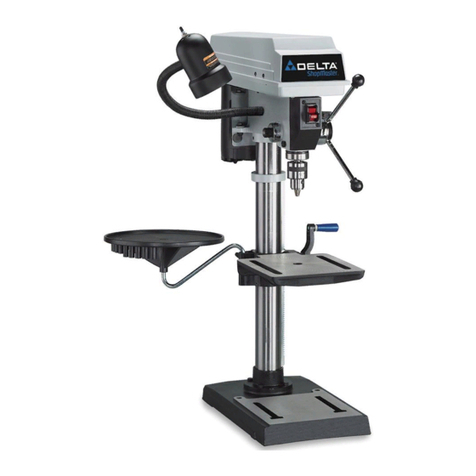
Delta
Delta DP300L User manual
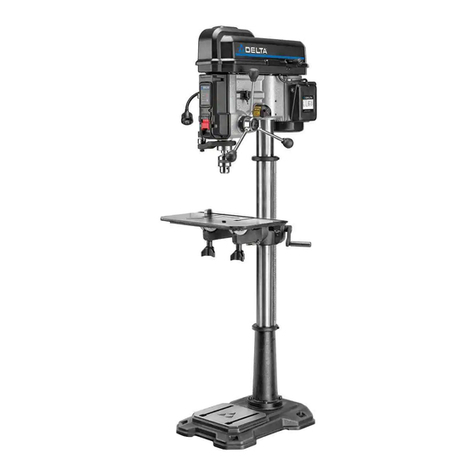
Delta
Delta 18-900L User manual
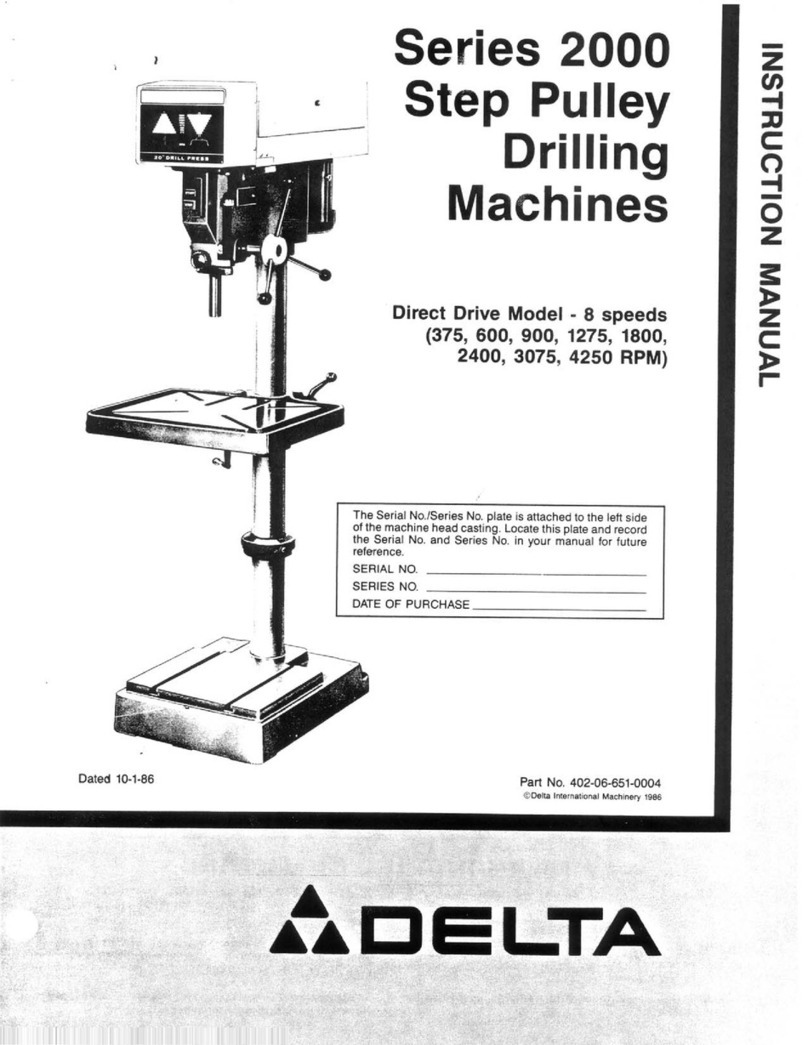
Delta
Delta 1275 User manual
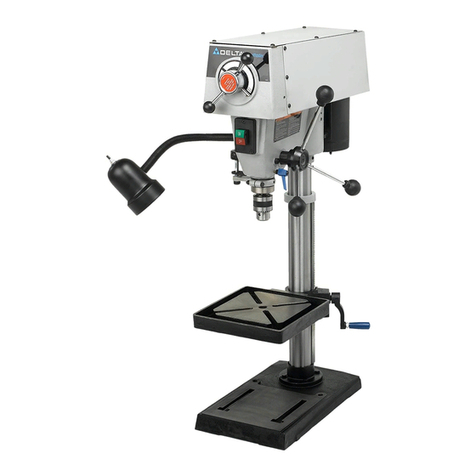
Delta
Delta ShopMaster DP350 User manual
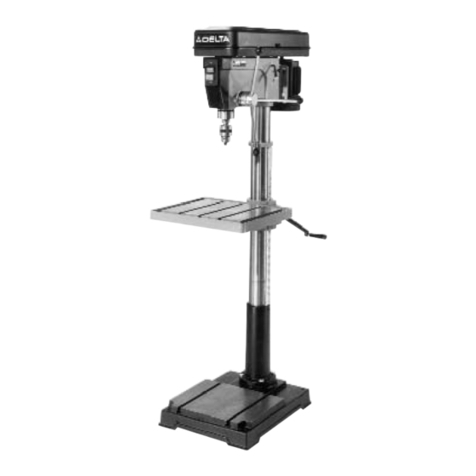
Delta
Delta 70-200 User manual
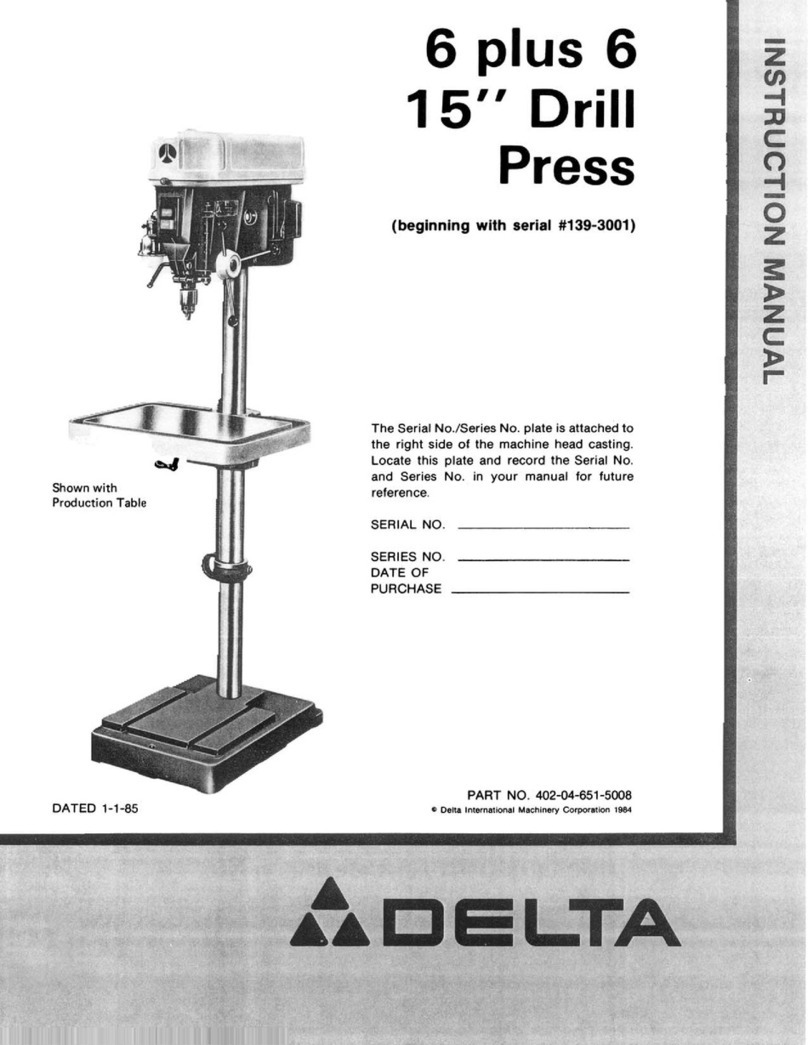
Delta
Delta 6 plus 6 15" Drill Press User manual
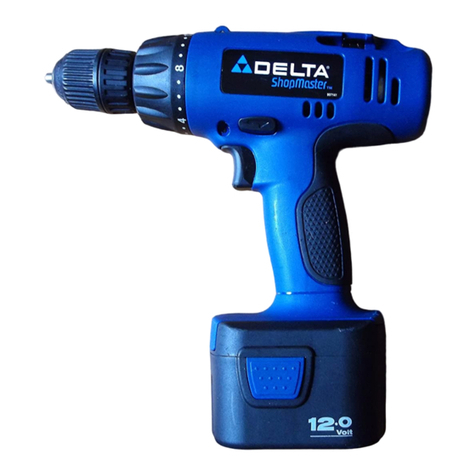
Delta
Delta CL120 User manual
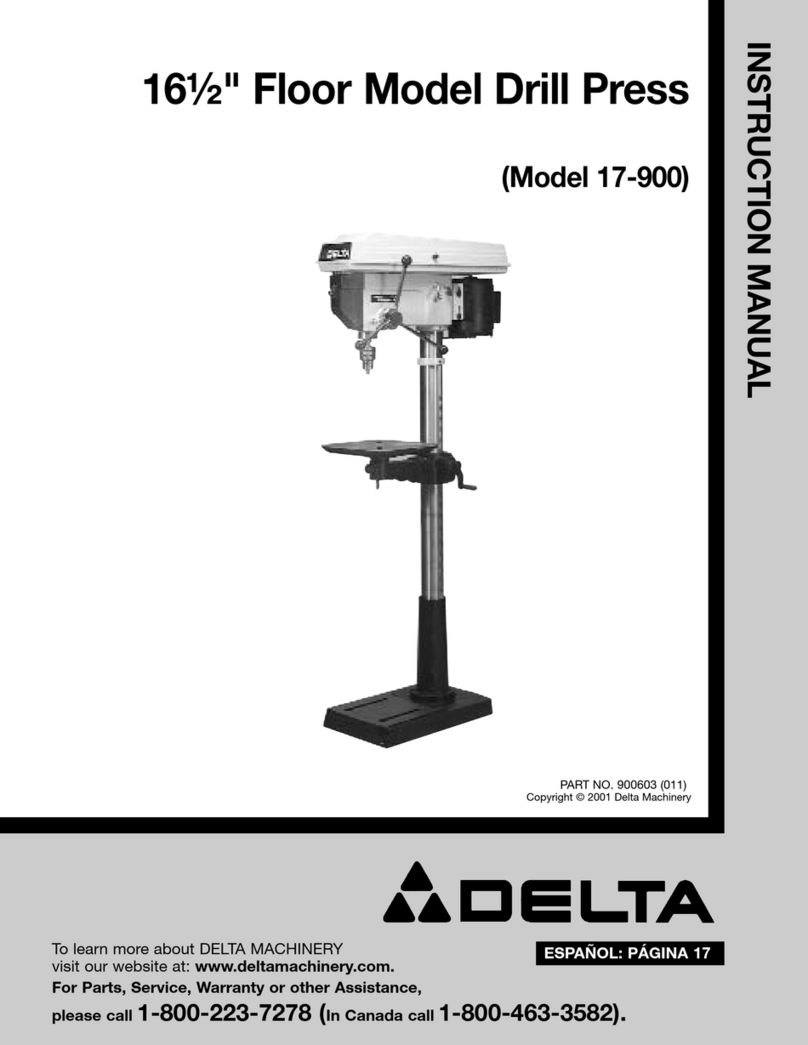
Delta
Delta 17-900 User manual
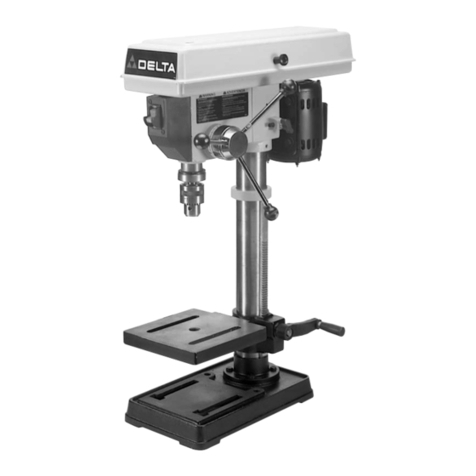
Delta
Delta 11-985 User manual
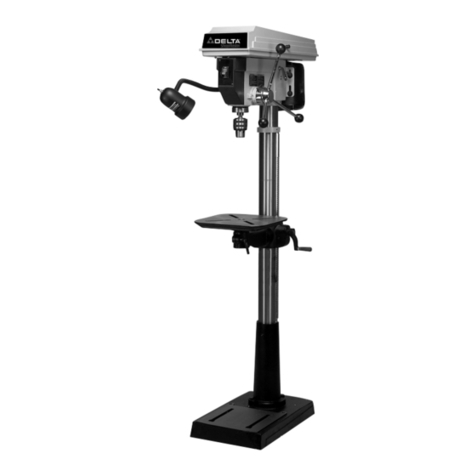
Delta
Delta ShopMaster DP400 User manual
